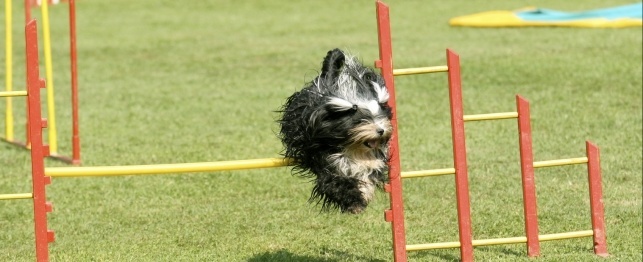Dog communications go well beyond one word commands like sit, stay, and down. There are many other dog training tools to help you, such as non-verbal communications (body language). Teaching your dog the basic commands is a great way to get your dog to understand what is expected of him, but it's just the beginning.
You should not have to constantly give your dog commands. He should know instinctively from your previous training that he should not do things like climb onto the furniture, scratch at the door when you go out, shred your personal belongings or bark at every sound he hears. Body language is a great way to let him know right from wrong.
When trained properly, your dog and you will have a better understanding of the rules and the messages being delivered between you. As you learn his body language, he comes to learn yours.
Both species communicate using body language, dogs moreso. While a dog will make different sounds to communicate, he combines them with body stances that are quickly understood by other canines. This is where we are at a disadvantage until we learn that language.
As humans speak or stand a certain way to demonstrate our feelings, dogs have no idea what we mean. When angry, relaxed or stressed we hold our bodies in a certain way. Sometimes those forms of communication are interpreted entirely different by dogs. Similar poses can have opposite meanings for them.
As you spend time with your dog, you'll come to recognize his poses and how to interpret them, as he will yours. Work on this and you'll soon see how effective it can be, especially when you add it to other positive training methods.
Dog communications benefit best with positive training methods
Positive reinforcement will bring quicker and better results than other responses. Patience will go a long way when your dog does not understand your command. It is far more effective than shouting and beating your dog.
You both are learning a language that is not your own, which makes this a training process for you as well as your dog. Because you have the thought processes that are more able to establish cause and effect, you are in a better position to learn his language and modify your own rather than the reverse.
Herding dogs are an excellent example of how dogs can do well with body language commands. Their trainers have mastered the art of teaching their dogs to know instictively what to do without constant instruction. Instincts, a simple whistle or a hand signal is all the dog needs to get the job done. They know what their job entails - rounding up the sheep - and they do it expertly.
This is a perfect example of how non-verbal communications can work between an owner and his dog. It takes many hours of practice to reach this stage. It is not reached with physical punishment for non-compliance. Praise is far more beneficial and helps you to develop a closer relationship with your pet.
Dog communications does take a great deal of patience, but the rewards are well worth the time and commitment.

 Parks & Recreation: 7 Tips for Enjoying Dog Parks
Parks & Recreation: 7 Tips for Enjoying Dog P
Parks & Recreation: 7 Tips for Enjoying Dog Parks
Parks & Recreation: 7 Tips for Enjoying Dog P
 Stop Dog Digging: Find Fun And Easy Ways To Train Your Dog
A lot of people are trying to maintain a clean home these
Stop Dog Digging: Find Fun And Easy Ways To Train Your Dog
A lot of people are trying to maintain a clean home these
 How To Deal With Dogs That Dig
How To Deal With Dogs That Dig
Digging can be a fr
How To Deal With Dogs That Dig
How To Deal With Dogs That Dig
Digging can be a fr
 Agility: an Exciting Dog Sport
Agility: an Exciting Dog Sport
Agility: an Exciting Dog Sport
Agility: an Exciting Dog Sport
 How To Use Vibration Dog Training Collars
All dogs need training at least, no matter how smart the do
How To Use Vibration Dog Training Collars
All dogs need training at least, no matter how smart the do